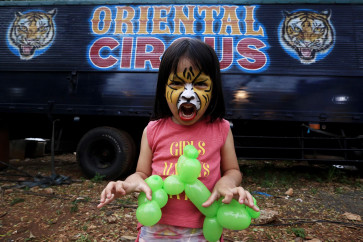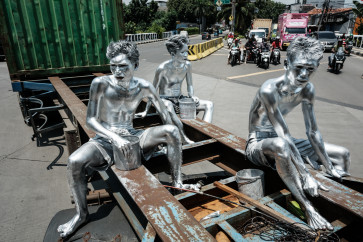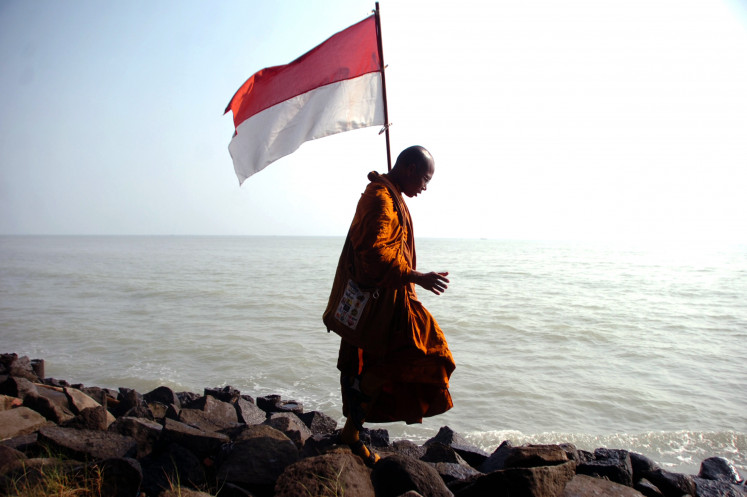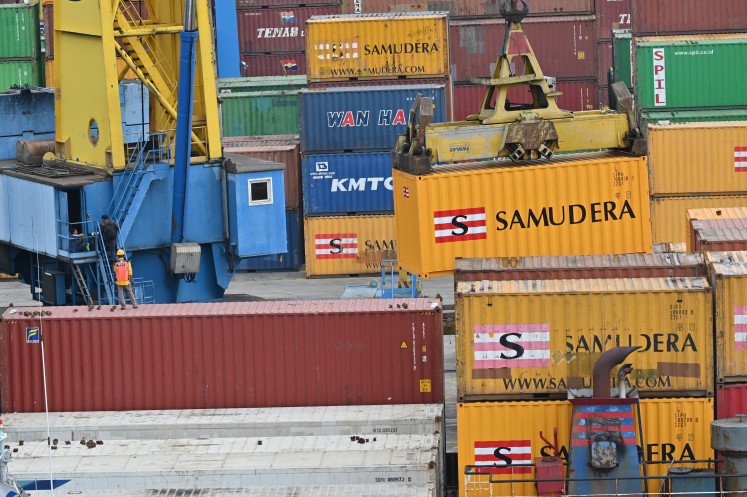Tourists and disaster in Indonesia
What should tourists do when the disaster happens in the tourist destination?
Change text size
Gift Premium Articles
to Anyone
 A tropical sandy beach at Gili Trawangan. (Shutterstock/File)
A tropical sandy beach at Gili Trawangan. (Shutterstock/File)
I
ndonesia is a beautiful country and has many attractive tourists destination. Indonesia’s mountains, beaches, waves, and culture have attracted millions of tourists from different countries in the world to come. They enjoy the beautiful scenery, calm in the serenity on the top of the mountain, stay in the beaches and surf on the wave, and witness various cultural attractions.
On the other hand, Indonesia is also prone to different types of disaster. Its geographical, meteorological, and geological conditions make the country has many kinds of natural hazards. In terms of geological circumstance, the country is part of the Pacific Ring of Fire marked by many active volcanoes, earthquakes, and tsunamis. In meteorological case, the country experiences flood and landslide during the wet season and drought in the dry season. Furthermore, during an extremely dry season, forest fire also occurs in some provinces.
In several locations of the country, tourist destinations are adjacent to the hazard zone. For example, many tourists come to the western coast of Sumatera where many beautiful islands with its beaches and waves are located, such as Mentawai and Simeulue. However, near these tourist destinations are also the subduction zone where several earthquakes and tsunamis have occurred.
During the period at the end of 2017 to the mid of 2018, several disasters occurred in the tourists' destination. For example in November to December 2017, Mount Agung, an active volcano and one of the tourist destinations in Bali, increased its activities. Furthermore, in July to Augusts 2018, several earthquakes hit Lombok which also a famous tourist destination next to Bali.
As a result of these events, many tourists were affected by the disasters. In Mount Agung, they have to avoid the danger zone. Meanwhile, in Lombok, tourists who visited Mount Rinjani and three Gilis islands had to be evacuated. In turn, these circumstances have disturbed tourists from enjoying their vacation.
A disaster event which occurs in a tourist destination should be acknowledged and respond by tourists. However, it is unlikely that they are ready for responding to the disaster during their travel. This circumstance causes a question, what should tourists do when the disaster happens in the tourist destination?
In my opinion, there are three measures that need to be taken for tourists in facing disaster in their destination. Firstly, they need to prepare themselves prior to their travel. Aside from preparing for the accommodation and transportation, they also should consider the information regarding the risk of the disaster that might be occurred in their destination. This measure is important for planning and determining what action should be taken when the disaster occurred.
In order to understand the disaster risk and anticipation measure to face the disaster in a particular area, tourists can utilize InaRISK Personal. This is an Android-based app that can be downloaded from Google Play Store to an Android smartphone. By this application, not only tourist can understand what type of disaster in a particular area, but they also can gather the information regarding the method to anticipate if such a disaster happened.
Upon on their arrival in Indonesia or some tourist destinations, it is recommended that tourists make a report to their embassy. It is also suggested that they record the contact of the embassy just in case they will need it later in an emergency situation. It is also paramount for tourists to give the information regarding their itinerary to the embassy as this will help the embassy and Indonesian government to locate anyone that visited the country in a particular time.
Before their arrival, tourists also can learn the local wisdom in facing a disaster. For example, if they would like to visit Simeulue, in Aceh that famous for its wave, they can learn Smong. This is a call in Simeulue after an earthquake for people to run to the hills and avoid beach area just in case there is a potential of the tsunami. This local wisdom has been proven for saving many people in Simeulue during the big earthquake in 2004.
By making preparation before their travel, it is expected that tourists will be ready once the disaster occurred. They will understand what measure should be taken according to the type of the disaster. For example, they can bring masks, long-sleeved clothes, and hats to the area with the risk of volcano hazard. They also can prefer single stories accommodation completed with the evacuation zone in an area that risk towards earthquake and tsunami. An additional food and drinking water also would be a good idea to be prepared just in case the disaster happened.
Secondly, tourists need to take an appropriate measure when the disaster does occur. For example, they should avoid the hazard zone in the case of the volcano eruption. For earthquake and tsunami hazard, they should follow the order from the authority to avoid the beach area and move towards the evacuation shelter. Yet, if they are trapped in the mountain or an island they should not be panicked. They can contact the embassy or the government authority for rescue. They also should not make any dangerous decision by themselves that can cause further unexpected impacts.
Thirdly, when the disaster ceased tourists can become a victim or responder and helping other. As a responder, they can help and provide basic needs for those who are affected. This case happened in Rinjani in July 2018. Several tourists from England previously had trapped in the top of the mountain, once they were rescued then they provided basic needs for the local communities who lived in the camp.
Tourists also should be aware of the information or news that they obtain from the internet. They have to make sure that this information is from the authority or trusted media as there are many hoaxes that spread out to make a panic after a disaster event.
By understanding several measures before, during, and after the disaster occurred in the tourists' destination, tourists can make a good preparation and are more ready for facing the potential disaster. Therefore, with this knowledge they should not be afraid of enjoying beautiful scenery, staying on the beach, and surfing on the waves. Even, they can be a responder and help those affected populations.
Happy visit and enjoy tourists destination in Indonesia.
***
The writer is an alumnus of Master of Environmental Management and Development, the Australian National University.









